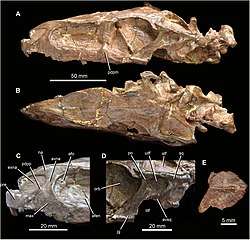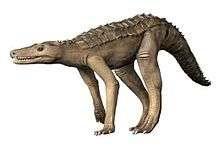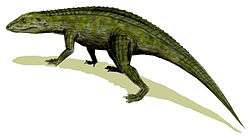Turfanosuchus
| Turfanosuchus | |
|---|---|
 | |
| Multiple views of the holotype skull of Turfanosuchus dabanensis | |
| Scientific classification | |
| Kingdom: | Animalia |
| Phylum: | Chordata |
| Class: | Reptilia |
| Clade: | Pseudosuchia |
| Clade: | Suchia |
| Family: | †Gracilisuchidae |
| Genus: | †Turfanosuchus Young, 1973 |
| Species | |
| |
Turfanosuchus is a genus of archosauriform reptile, likely a gracilisuchid, which lived during the Middle Triassic (Anisian) of northwestern China. The type species, T. dabanensis, was described by C.C. Young in 1973, based on a partially complete but disarticulated fossil skeleton (IVPP V.32237) found in the Kelamayi Formation of the Turfan Basin.[1]
Classification

The classification of Turfanosuchus has gone through much revision in the past due to its combination of features from both suchian archosaurs and earlier archosaur relatives such as Euparkeria. Young originally believed that the fossils came from an animal similar to Euparkeria, and assigned it to the family Euparkeriidae. The fossil, however, was not fully prepared. Subsequent analysis by Parrish in 1993 indicated that the fossils represented a suchian.
In 2001, Xiao-Chun Wu (of the Institute of Vertebrate Paleontology and Paleoanthropology in Beijing) and Anthony Russell (of the University of Calgary) redescribed the fossil. Wu and Russell prepared the fossil, and noted the limb bones (femur and humerus) resembled those of Ticinosuchus and Euparkeria, though the calcaneum did not. Further preparation revealed a partial osteoderm. Wu and Russell concluded that Turfanosuchus was not a suchian nor even a member of the Pseudosuchia (archosaurs closer to crocodilians than to dinosaurs, also known as Crurotarsi in publications which include phytosaurs in the group). This conclusion was supported by features such as teeth on the palate and internal carotid arteries which entered the braincase from below, rather than from the side. They also ruled out the possibility of a close relationship with Euparkeria.[2]
In 2010, paleontologists Martín Ezcurra, Agustina Lecuona, and Augustín Martinelli found Turfanosuchus to be a pseudosuchian once again during the study of the recently discovered archosauriform Koilamasuchus. This reassignment was based on the structure of the calcaneum (heel bone), which is similar to that of other early pseudosuchians, especially aetosaurs.[3] This conclusion was also supported in 2011 by Sterling Nesbitt's comprehensive analysis on archosaurs and archosauriforms. This analysis noted that some archosaurs (such as Eoraptor) also had palatal teeth, and other (such as Silesaurus and early poposauroids) had internal carotid arteries which entered the braincase from below.[4]
In 2014, Turfanosuchus was found to be closely related to the small suchians Gracilisuchus and Yonghesuchus, in the newly created family Gracilisuchidae. Most of the similarities justifying this classification were present in the skull.[5]

References
- ↑ Turfanosuchus at Fossilworks.org
- ↑ Wu, Xiao-Chun; Russell, Anthony (2001). "Redescription of Turfanosuchus dabanensis (Archosauriformes) and new information on its phylogenetic relationships" (PDF). Journal of Vertebrate Paleontology. 21 (1): 40–50. doi:10.1671/0272-4634(2001)021[0040:ROTDAA]2.0.CO;2. ISSN 0272-4634. Archived from the original (PDF) on 2011-07-16. Retrieved 2008-06-08.
- ↑ Ezcurra, M.D.; Lecuona, A.; Martinelli, A. (2010). "A new basal archosauriform diapsid from the Lower Triassic of Argentina". Journal of Vertebrate Paleontology. 30 (5): 1433–1450. doi:10.1080/02724634.2010.501446.
- ↑ Nesbitt, S.J. (2011). "The early evolution of archosaurs: relationships and the origin of major clades" (PDF). Bulletin of the American Museum of Natural History. 352: 1–292. doi:10.1206/352.1. hdl:2246/6112.
- ↑ Butler, Richard J; Sullivan, Corwin; Ezcurra, Martín D; Liu, Jun; Lecuona, Agustina; Sookias, Roland B (2014). "New clade of enigmatic early archosaurs yields insights into early pseudosuchian phylogeny and the biogeography of the archosaur radiation". BMC Evolutionary Biology. 14 (1): 128. doi:10.1186/1471-2148-14-128. ISSN 1471-2148. PMC 4061117. PMID 24916124.


